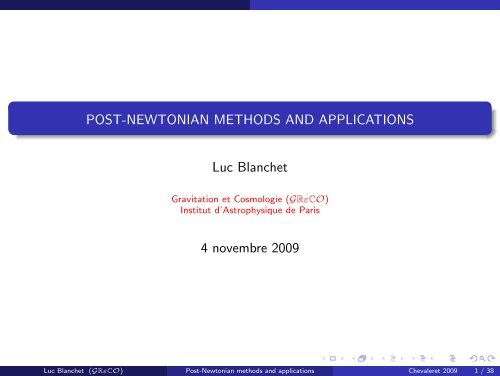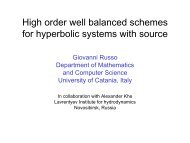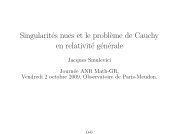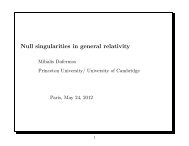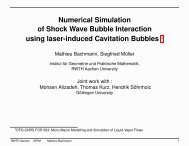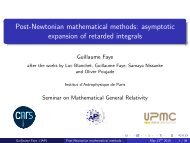Post-Newtonian methods and applications - Philippe G. LeFloch
Post-Newtonian methods and applications - Philippe G. LeFloch
Post-Newtonian methods and applications - Philippe G. LeFloch
You also want an ePaper? Increase the reach of your titles
YUMPU automatically turns print PDFs into web optimized ePapers that Google loves.
POST-NEWTONIAN METHODS AND APPLICATIONS<br />
Luc Blanchet<br />
Gravitation et Cosmologie (GRεCO)<br />
Institut d’Astrophysique de Paris<br />
4 novembre 2009<br />
Luc Blanchet (GRεCO) <strong>Post</strong>-<strong>Newtonian</strong> <strong>methods</strong> <strong>and</strong> <strong>applications</strong> Chevaleret 2009 1 / 38
Ground-based laser interferometric detectors<br />
LIGO GEO<br />
LIGO/VIRGO/GEO observe the GWs in<br />
the high-frequency b<strong>and</strong><br />
10 Hz f 10 3 Hz<br />
VIRGO<br />
Luc Blanchet (GRεCO) <strong>Post</strong>-<strong>Newtonian</strong> <strong>methods</strong> <strong>and</strong> <strong>applications</strong> Chevaleret 2009 2 / 38
Space-based laser interferometric detector<br />
LISA<br />
LISA will observe the GWs in the low-frequency b<strong>and</strong><br />
10 −4 Hz f 10 −1 Hz<br />
Luc Blanchet (GRεCO) <strong>Post</strong>-<strong>Newtonian</strong> <strong>methods</strong> <strong>and</strong> <strong>applications</strong> Chevaleret 2009 3 / 38
The inspiral <strong>and</strong> merger of compact binaries<br />
Neutron stars spiral <strong>and</strong> coalesce Black holes spiral <strong>and</strong> coalesce<br />
1 Neutron star (M = 1.4 M⊙) events will be detected by ground-based<br />
detectors LIGO/VIRGO/GEO<br />
2 Stellar size black hole (5 M⊙ M 20 M⊙) events will also be detected by<br />
ground-based detectors<br />
3 Supermassive black hole (10 5 M⊙ M 10 8 M⊙) events will be detected<br />
by the space-based detector LISA<br />
Luc Blanchet (GRεCO) <strong>Post</strong>-<strong>Newtonian</strong> <strong>methods</strong> <strong>and</strong> <strong>applications</strong> Chevaleret 2009 4 / 38
Supermassive black-hole coalescences as detected by LISA<br />
When two galaxies collide their central supermassive black holes may form a<br />
bound binary system which will spiral <strong>and</strong> coalesce. LISA will be able to detect the<br />
gravitational waves emitted by such enormous events anywhere in the Universe<br />
Luc Blanchet (GRεCO) <strong>Post</strong>-<strong>Newtonian</strong> <strong>methods</strong> <strong>and</strong> <strong>applications</strong> Chevaleret 2009 5 / 38
GRAVITATIONAL WAVE TEMPLATES<br />
Luc Blanchet (GRεCO) <strong>Post</strong>-<strong>Newtonian</strong> <strong>methods</strong> <strong>and</strong> <strong>applications</strong> Chevaleret 2009 6 / 38
Methods to compute gravitational-wave templates<br />
4<br />
3<br />
2<br />
1<br />
0<br />
log 10 (r 12 /m)<br />
<strong>Post</strong><strong>Newtonian</strong><br />
Theory<br />
Numerical<br />
Relativity<br />
0 1 2 3<br />
<strong>Post</strong><strong>Newtonian</strong><br />
Theory<br />
&<br />
Perturbation<br />
Theory<br />
Perturbation<br />
Theory<br />
4<br />
log 10 (m 2 /m 1 )<br />
Luc Blanchet (GRεCO) <strong>Post</strong>-<strong>Newtonian</strong> <strong>methods</strong> <strong>and</strong> <strong>applications</strong> Chevaleret 2009 7 / 38
Methods to compute gravitational-wave templates<br />
4<br />
3<br />
2<br />
1<br />
0<br />
log 10 (r 12 /m)<br />
<strong>Post</strong><strong>Newtonian</strong><br />
Theory<br />
Numerical<br />
Relativity<br />
m 2<br />
r 12<br />
0 1 2 3<br />
m 1<br />
<strong>Post</strong><strong>Newtonian</strong><br />
Theory<br />
&<br />
Perturbation<br />
Theory<br />
Perturbation<br />
Theory<br />
4<br />
log 10 (m 2 /m 1 )<br />
Luc Blanchet (GRεCO) <strong>Post</strong>-<strong>Newtonian</strong> <strong>methods</strong> <strong>and</strong> <strong>applications</strong> Chevaleret 2009 7 / 38
Methods to compute gravitational-wave templates<br />
4<br />
3<br />
2<br />
1<br />
0<br />
log 10 (r 12 /m)<br />
<strong>Post</strong><strong>Newtonian</strong><br />
Theory<br />
Numerical<br />
Relativity<br />
0 1 2 3<br />
<strong>Post</strong><strong>Newtonian</strong><br />
Theory<br />
&<br />
Perturbation<br />
Theory<br />
Perturbation<br />
Theory<br />
4<br />
m 1<br />
log 10 (m 2 /m 1 )<br />
Luc Blanchet (GRεCO) <strong>Post</strong>-<strong>Newtonian</strong> <strong>methods</strong> <strong>and</strong> <strong>applications</strong> Chevaleret 2009 7 / 38<br />
m 2
Methods to compute gravitational-wave templates<br />
4<br />
3<br />
2<br />
1<br />
0<br />
log 10 (r 12 /m)<br />
<strong>Post</strong><strong>Newtonian</strong><br />
Theory<br />
Numerical<br />
Relativity<br />
0 1 2 3<br />
<strong>Post</strong><strong>Newtonian</strong><br />
Theory<br />
&<br />
Perturbation<br />
Theory<br />
Perturbation<br />
Theory<br />
4<br />
log 10 (m 2 /m 1 )<br />
Luc Blanchet (GRεCO) <strong>Post</strong>-<strong>Newtonian</strong> <strong>methods</strong> <strong>and</strong> <strong>applications</strong> Chevaleret 2009 7 / 38
The inspiral (or chirp) of compact binary systems<br />
The most interesting known source of gravitational waves for the<br />
LIGO/VIRGO detectors <strong>and</strong> a very important one for LISA<br />
The dynamics of these systems is driven by gravitational radiation reaction<br />
effects or equivalently by the loss of energy by gravitational radiation<br />
Theoretical waveforms (templates) for detection <strong>and</strong> analysis of the signals<br />
should be very accurate in terms of a post-<strong>Newtonian</strong> expansion<br />
<strong>Post</strong>-<strong>Newtonian</strong> waveforms for the inspiral should be completed by numerical<br />
calculations of the merger <strong>and</strong> ringdown phases<br />
Luc Blanchet (GRεCO) <strong>Post</strong>-<strong>Newtonian</strong> <strong>methods</strong> <strong>and</strong> <strong>applications</strong> Chevaleret 2009 8 / 38
PN templates for inspiralling compact binaries<br />
d<br />
i<br />
r<br />
e<br />
c<br />
t<br />
i<br />
o<br />
n<br />
a<br />
s<br />
c<br />
e<br />
n<br />
d<br />
i<br />
n<br />
g<br />
n<br />
o<br />
d<br />
e<br />
m 2<br />
ascending node<br />
<br />
i<br />
observer<br />
m 1<br />
orbital plane<br />
The orbital phase φ(t) should be monitored in<br />
LIGO/VIRGO detectors with precision<br />
δφ ∼ π<br />
φ(t) = φ0 −<br />
o<br />
f<br />
1<br />
<br />
GMω<br />
32ν c3 −5/3 1 +<br />
<br />
result of the quadrupole formalism<br />
(sufficient for the binary pulsar)<br />
1PN 1.5PN<br />
+<br />
c2 c3 <br />
3PN<br />
+ · · · + + · · ·<br />
c6 <br />
needs to be computed with high PN precision<br />
Detailed data analysis (using the sensitivity noise curve of LIGO/VIRGO<br />
detectors) show that the required precision is at least 2PN for detection <strong>and</strong> 3PN<br />
for parameter estimation<br />
Luc Blanchet (GRεCO) <strong>Post</strong>-<strong>Newtonian</strong> <strong>methods</strong> <strong>and</strong> <strong>applications</strong> Chevaleret 2009 9 / 38
Matching the PN inspiral to numerical merger waveforms<br />
The numerical merger waveform is matched with high accuracy to the PN inspiral<br />
waveform. Current precision of the PN waveform is<br />
3.5PN order in phase [LB, Faye, Iyer & Joguet 2002; LB, Damour, Esposito-Farèse & Iyer 2004]<br />
3PN order in amplitude [LB, Faye, Iyer & Siddhartha 2008]<br />
Luc Blanchet (GRεCO) <strong>Post</strong>-<strong>Newtonian</strong> <strong>methods</strong> <strong>and</strong> <strong>applications</strong> Chevaleret 2009 10 / 38
PN prediction for the ICO of binary black holes<br />
The convergence of the st<strong>and</strong>ard Taylor<br />
exp<strong>and</strong>ed PN series is very good.<br />
Numerical point is from [Gourgoulhon,<br />
Gr<strong>and</strong>clément & Bonazzola 2001]<br />
There is an excellent agreement with the<br />
st<strong>and</strong>ard 3PN prediction. Numerical<br />
points are from [Caudill, Cook, Grigsby & Pfeiffer<br />
2006]<br />
Luc Blanchet (GRεCO) <strong>Post</strong>-<strong>Newtonian</strong> <strong>methods</strong> <strong>and</strong> <strong>applications</strong> Chevaleret 2009 11 / 38
PN contributions to the number of GW cycles<br />
Table: PN cycles accumulated in the b<strong>and</strong>width of LIGO/VIRGO<br />
(10 + 10)M⊙<br />
(1.4 + 1.4)M⊙<br />
<strong>Newtonian</strong> 601 16034<br />
1PN +59.3 +441<br />
1.5PN −51.4+16.0 κ1 χ1 + 16.0 κ2 χ2 −211+65.7 κ1 χ1 + 65.7 κ2 χ2<br />
2PN +4.1−3.3 κ1 κ2 χ1 χ2 + 1.1 ξ χ1 χ2 +9.9−8.0 κ1 κ2 χ1 χ2 + 2.8 ξ χ1 χ2<br />
2.5PN<br />
3PN<br />
−7.1+5.5 κ1 χ1 + 5.5 κ2 χ2<br />
+2.2<br />
−11.7+9.0 κ1 χ1 + 9.0 κ2 χ2<br />
+2.6<br />
3.5PN −0.8 −0.9<br />
Table: PN cycles accumulated in the b<strong>and</strong>width of LISA<br />
(10 6 + 10 6 )M⊙<br />
(10 5 + 10 5 )M⊙<br />
<strong>Newtonian</strong> 2267 9570<br />
1PN +134 +323<br />
1.5PN −92.4+28.8 κ1 χ1 + 28.8 κ2 χ2 −170+53 κ1 χ1 + 53 κ2 χ2<br />
2PN +6.0−4.8 κ1 κ2 χ1 χ2 + 1.7 ξ χ1 χ2 +8.7−7.1 κ1 κ2 χ1 χ2 + 2.4 ξ χ1 χ2<br />
2.5PN −9.0+6.9 κ1 χ1 + 6.9 κ2 χ2 −11.0+8.5 κ1 χ1 + 8.5 κ2 χ2<br />
3PN +2.3 +2.5<br />
3.5PN −0.9 −0.9<br />
Spin effects are indicated in green <strong>and</strong> tail effects are in red<br />
Luc Blanchet (GRεCO) <strong>Post</strong>-<strong>Newtonian</strong> <strong>methods</strong> <strong>and</strong> <strong>applications</strong> Chevaleret 2009 12 / 38
GRAVITATIONAL SELF-FORCE THEORY<br />
Luc Blanchet (GRεCO) <strong>Post</strong>-<strong>Newtonian</strong> <strong>methods</strong> <strong>and</strong> <strong>applications</strong> Chevaleret 2009 13 / 38
General problem of the self-force<br />
A particle is moving on a background<br />
space-time<br />
Its own stress-energy tensor modifies the<br />
background gravitational field<br />
Because of the “back-reaction” the motion<br />
of the particle deviates from a background<br />
geodesic hence the appearance of a self force<br />
u <br />
u<br />
f<br />
The self acceleration of the particle is proportional to its mass<br />
Dū µ<br />
dτ = f µ <br />
m1<br />
= O<br />
The gravitational self force includes both dissipative (radiation reaction) <strong>and</strong><br />
conservative effects.<br />
Luc Blanchet (GRεCO) <strong>Post</strong>-<strong>Newtonian</strong> <strong>methods</strong> <strong>and</strong> <strong>applications</strong> Chevaleret 2009 14 / 38<br />
m2<br />
m 1<br />
f <br />
m 2
Self-force in perturbation theory<br />
The space-time metric gµν is decomposed as a background metric ¯gµν plus<br />
hµν = linearized parturbation of the background space-time<br />
The field equation in an harmonic gauge reads<br />
u<br />
<br />
particle's trajectory<br />
<br />
z<br />
h µν µ ν<br />
+ 2R ρ σ h ρσ = −16π T µν<br />
x<br />
The retarded solution is<br />
h µν <br />
µν<br />
(x) = 4m1 G ρσ(x, z) ū<br />
ret<br />
ρ ū σ + O(m 2 1)<br />
Luc Blanchet (GRεCO) <strong>Post</strong>-<strong>Newtonian</strong> <strong>methods</strong> <strong>and</strong> <strong>applications</strong> Chevaleret 2009 15 / 38<br />
Γ
Green function responsible for the self-force [Detweiler & Whiting 2003]<br />
The symmetric (S) Green function is defined by the prescription<br />
G =<br />
S<br />
1<br />
<br />
G<br />
2 ret + G <br />
−H<br />
adv<br />
where H is homogeneous solution of the wave equation<br />
1 GS is symmetric under a time reversal hence corresponds to stationary waves<br />
at infinity <strong>and</strong> does not produce a reaction force on the particle<br />
2 It has the same divergent behavior as Gret on the particle’s worldline<br />
3 It is non zero only when x <strong>and</strong> z are related by a space-like interval<br />
The radiative (R) Green function responsible for the self force is then<br />
G(x, z) = G(x, z) − G(x, z) =<br />
R<br />
ret S<br />
1<br />
<br />
G<br />
2 ret − G <br />
+H<br />
adv<br />
Luc Blanchet (GRεCO) <strong>Post</strong>-<strong>Newtonian</strong> <strong>methods</strong> <strong>and</strong> <strong>applications</strong> Chevaleret 2009 16 / 38
Causal behaviour of the radiative Green function<br />
The radiative Green function is<br />
1 causal in the sense that<br />
G(x) = lim G(x, z)<br />
R x→z R<br />
depends only on the particle’s past history<br />
2 smooth (i.e. C ∞ ) on the particle’s trajectory<br />
z<br />
G (x,z)<br />
ret<br />
z<br />
x<br />
G (x,z)<br />
S<br />
x<br />
z<br />
G (x,z)<br />
adv<br />
z<br />
G (x,z)<br />
R<br />
Luc Blanchet (GRεCO) <strong>Post</strong>-<strong>Newtonian</strong> <strong>methods</strong> <strong>and</strong> <strong>applications</strong> Chevaleret 2009 17 / 38<br />
x<br />
x
Computation of the self-force [Mino, Sasaki & Tanaka 1997; Quinn & Wald 1997]<br />
The metric perturbation is decomposed as<br />
hµν = h µν<br />
S<br />
<br />
+ h µν<br />
R<br />
<br />
particular solution homogeneous solution<br />
The particular solution h µν<br />
S (symmetric in a time reversal) diverges on the<br />
particle’s location but the homogeneous solution h µν<br />
R is perfectly regular<br />
The self-force f µ is computed from the geodesic motion with respect to<br />
g SF<br />
µν ≡ ¯gµν + h R µν<br />
The divergence on the particle’s trajectory due to GS can be renormalized in a<br />
redefinition of the particle’s mass<br />
Luc Blanchet (GRεCO) <strong>Post</strong>-<strong>Newtonian</strong> <strong>methods</strong> <strong>and</strong> <strong>applications</strong> Chevaleret 2009 18 / 38
POST-NEWTONIAN VERSUS SELF-FORCE PREDICTIONS<br />
Luc Blanchet (GRεCO) <strong>Post</strong>-<strong>Newtonian</strong> <strong>methods</strong> <strong>and</strong> <strong>applications</strong> Chevaleret 2009 19 / 38
Common regime of validity of SF <strong>and</strong> PN<br />
4<br />
3<br />
2<br />
1<br />
0<br />
log 10 (r 12 /m)<br />
<strong>Post</strong><strong>Newtonian</strong><br />
Theory<br />
Numerical<br />
Relativity<br />
0 1 2 3<br />
<strong>Post</strong><strong>Newtonian</strong><br />
Theory<br />
&<br />
Perturbation<br />
Theory<br />
Perturbation<br />
Theory<br />
4<br />
log 10 (m 2 /m 1 )<br />
Luc Blanchet (GRεCO) <strong>Post</strong>-<strong>Newtonian</strong> <strong>methods</strong> <strong>and</strong> <strong>applications</strong> Chevaleret 2009 20 / 38<br />
m 2<br />
r 12<br />
m 1
Motivation for this work [LB, Detweiler, Le Tiec & Whiting 2009]<br />
Both the PN <strong>and</strong> SF approaches use a self-field regularization for point particles<br />
followed by a renormalization. However, the prescription are very different<br />
1 SF theory is based on a prescription for the Green function GR that is at once<br />
regular <strong>and</strong> causal<br />
2 PN theory uses dimensional regularization <strong>and</strong> it was shown that subtle issues<br />
appear at the 3PN order due to the appearance of poles ∝ (d − 3) −1<br />
How can we make a meaningful comparison?<br />
To find a gauge-invariant observable computable in both formalisms<br />
Luc Blanchet (GRεCO) <strong>Post</strong>-<strong>Newtonian</strong> <strong>methods</strong> <strong>and</strong> <strong>applications</strong> Chevaleret 2009 21 / 38
Circular orbits admit a helical Killing vector<br />
Black hole<br />
u <br />
1<br />
Particle's trajectory<br />
Light cylinder<br />
<br />
k 1<br />
k k<br />
Luc Blanchet (GRεCO) <strong>Post</strong>-<strong>Newtonian</strong> <strong>methods</strong> <strong>and</strong> <strong>applications</strong> Chevaleret 2009 22 / 38
Choice of a gauge-invariant observable [Detweiler 2008]<br />
1 For exactly circular orbits the geometry admits a<br />
helical Killing vector (HKV) with<br />
k µ ∂µ = ∂t + ω ∂ϕ (asymptotically)<br />
2 The four-velocity of the particle is necessarily<br />
tangent to the HKV hence<br />
u µ<br />
1 = uT1 k µ<br />
1<br />
3 The relation u T 1 (ω) is well-defined in both PN <strong>and</strong><br />
SF approaches <strong>and</strong> is gauge-invariant<br />
Luc Blanchet (GRεCO) <strong>Post</strong>-<strong>Newtonian</strong> <strong>methods</strong> <strong>and</strong> <strong>applications</strong> Chevaleret 2009 23 / 38<br />
time<br />
m 2<br />
u <br />
<br />
u t<br />
space<br />
m 1
<strong>Post</strong>-<strong>Newtonian</strong> calculation<br />
In a coordinate system such that k µ ∂µ = ∂t + ω ∂ϕ everywhere this invariant<br />
quantity reduces to the zero component of the particle’s four-velocity,<br />
u t 1 =<br />
<br />
− Reg 1 [gµν]<br />
<br />
regularized metric<br />
v µ<br />
1 vν 1<br />
c2 −1/2 One needs a self-field regularization<br />
Hadamard regularization will yield an ambiguity at 3PN order<br />
Dimensional regularization will be free of any ambiguity at 3PN order<br />
Luc Blanchet (GRεCO) <strong>Post</strong>-<strong>Newtonian</strong> <strong>methods</strong> <strong>and</strong> <strong>applications</strong> Chevaleret 2009 24 / 38<br />
y 1<br />
v 1<br />
r 12<br />
v 2<br />
y 2
Dimensional regularization [’t Hooft & Veltman 1972]<br />
1 Perform the PN iteration in d spatial dimensions<br />
P (x) = ∆ −1 F (x) ≡ − k<br />
<br />
d<br />
4π<br />
d x ′ F (x ′ )<br />
|x ′ − x| d−2<br />
2 Obtain value when x → y1 using analytic dimensional continuation<br />
P (y1) = − k<br />
<br />
4π<br />
3 Exp<strong>and</strong> when ε ≡ d − 3 → 0 to obtain<br />
d d x<br />
F (x)<br />
r d−2<br />
1<br />
P (y1) = 1<br />
ε P−1(y1) + P0(y1) +O (ε)<br />
<br />
<br />
finite part<br />
pole part<br />
4 Compute the finite part by means of Hadamard’s partie finie<br />
Luc Blanchet (GRεCO) <strong>Post</strong>-<strong>Newtonian</strong> <strong>methods</strong> <strong>and</strong> <strong>applications</strong> Chevaleret 2009 25 / 38
3PN result for the gauge-invariant observable<br />
The result is expressed in terms of the orbital frequency through x ≡ GMω<br />
c3 3/2 as<br />
u T = 1 + CN x + C1PN x 2 + C2PN x 3 + C3PN x 4 + O(x 5 )<br />
The coefficients depend on mass ratios η ≡ m1m2/M 2 <strong>and</strong> ∆ ≡ (m1 − m2)/M.<br />
C3PN = 2835<br />
<br />
2835 2183 41<br />
+ ∆ − −<br />
256 256 48 64 π2<br />
<br />
12199 41<br />
η − −<br />
384 64 π2<br />
<br />
∆ η<br />
<br />
17201 41<br />
+ −<br />
576 192 π2<br />
<br />
η 2 + 795<br />
128 ∆ η2 − 2827<br />
864 η3 + 25<br />
1728 ∆ η3 + 35<br />
10368 η4<br />
We find that the poles ∝ ε −1 cancel out<br />
Luc Blanchet (GRεCO) <strong>Post</strong>-<strong>Newtonian</strong> <strong>methods</strong> <strong>and</strong> <strong>applications</strong> Chevaleret 2009 26 / 38
3PN prediction for the self-force<br />
With q ≡ m1/m2 ≪ 1 <strong>and</strong> y ≡ Gm2ω<br />
c3 3/2<br />
u T = u T Schw + q u T SF + q<br />
<br />
self-force<br />
2 u T PSF<br />
<br />
+O(q<br />
post-self-force<br />
3 )<br />
where u T SF = −y − 2y 2 − 5y 3 <br />
+ − 121 41<br />
+<br />
3 32 π2<br />
<br />
y 4 + O(y 5 )<br />
The 3PN self-force coefficient is [LB, Detweiler, Le Tiec & Whiting 2009]<br />
C3PN = − 121 41<br />
+<br />
3 32 π2 = −27.6879 · · ·<br />
which agrees with the SF numerical calculation at the 2σ level<br />
C SF<br />
3PN = −27.677 ± 0.005<br />
Luc Blanchet (GRεCO) <strong>Post</strong>-<strong>Newtonian</strong> <strong>methods</strong> <strong>and</strong> <strong>applications</strong> Chevaleret 2009 27 / 38
Comparison between PN <strong>and</strong> SF predictions<br />
u t SF<br />
0.5<br />
0.4<br />
0.3<br />
0.2<br />
0.1<br />
0<br />
N<br />
1PN<br />
2PN<br />
3PN<br />
Exact<br />
6 8 10 12 14 16 18 20<br />
y -1<br />
↑<br />
ISCO<br />
Luc Blanchet (GRεCO) <strong>Post</strong>-<strong>Newtonian</strong> <strong>methods</strong> <strong>and</strong> <strong>applications</strong> Chevaleret 2009 28 / 38
GRAVITATIONAL RECOIL OF BINARY BLACK HOLES<br />
Luc Blanchet (GRεCO) <strong>Post</strong>-<strong>Newtonian</strong> <strong>methods</strong> <strong>and</strong> <strong>applications</strong> Chevaleret 2009 29 / 38
Gravitational recoil of BH binaries<br />
The linear momentum ejection is in the direction of the lighter mass’ velocity<br />
v 2<br />
momentum<br />
ejection<br />
smaller mass<br />
m2 center−of−mass<br />
motion<br />
Vrecoil<br />
v<br />
1<br />
m<br />
1<br />
larger mass<br />
In the <strong>Newtonian</strong> approximation [with f(η) ≡ η 2√ 1 − 4η]<br />
4 6M f(η)<br />
Vrecoil = 20 km/s<br />
r fmax<br />
4 2M f(η)<br />
= 1500 km/s<br />
r<br />
fmax<br />
[Fitchett 1983]<br />
Luc Blanchet (GRεCO) <strong>Post</strong>-<strong>Newtonian</strong> <strong>methods</strong> <strong>and</strong> <strong>applications</strong> Chevaleret 2009 30 / 38
The 2PN linear momentum [LB, Qusailah & Will 2005]<br />
dP i<br />
dt<br />
GW<br />
1PN<br />
= − 464<br />
<br />
f(η) x11/2 1 + −<br />
105 452 1139<br />
−<br />
87 522 η<br />
tail<br />
<br />
309<br />
x + π x3/2<br />
58<br />
<br />
+ − 71345 36761 147101<br />
+ η +<br />
22968 2088 68904 η2<br />
<br />
x 2<br />
<br />
ˆλ<br />
<br />
2PN<br />
i<br />
The recoil of the center-of-mass follows from integrating<br />
dP i recoil<br />
dt<br />
= −<br />
dP i<br />
dt<br />
GW<br />
We find a maximum recoil velocity of 22 km/s at the ISCO<br />
Luc Blanchet (GRεCO) <strong>Post</strong>-<strong>Newtonian</strong> <strong>methods</strong> <strong>and</strong> <strong>applications</strong> Chevaleret 2009 31 / 38
Estimating the recoil during the plunge<br />
1 The plunge is approximated by that of a test particle of mass µ moving on a<br />
geodesic of the Schwarzschild metric of a BH of mass M<br />
2 The 2PN linear momentum flux is integrated on that orbit (y ≡ M/r)<br />
∆V i<br />
plunge = L<br />
ISCO<br />
M<br />
horizon<br />
ISCO<br />
plunging geodesic<br />
of Schwarzschild<br />
1<br />
M ω<br />
dP i <br />
dt<br />
dy<br />
E 2 − (1 − 2y)(1 + L 2 y 2 )<br />
E <strong>and</strong> L are the constant energy <strong>and</strong><br />
angular momentum of the Schwarzschild<br />
plunging orbit<br />
Luc Blanchet (GRεCO) <strong>Post</strong>-<strong>Newtonian</strong> <strong>methods</strong> <strong>and</strong> <strong>applications</strong> Chevaleret 2009 32 / 38
Recoil up to coalescence at r = 2M [LB, Qusailah & Will 2005]<br />
Luc Blanchet (GRεCO) <strong>Post</strong>-<strong>Newtonian</strong> <strong>methods</strong> <strong>and</strong> <strong>applications</strong> Chevaleret 2009 33 / 38
Comparison with numerical works<br />
v (km/s)<br />
v (km/s)<br />
300<br />
250<br />
200<br />
150<br />
100<br />
50<br />
0<br />
0 100 200 300<br />
t (M )<br />
ADM<br />
300<br />
250<br />
200<br />
150<br />
100<br />
50<br />
h1<br />
h2<br />
h3<br />
r 0 = 6.0 M<br />
r 0 = 7.0 M<br />
r 0 = 8.0 M<br />
0<br />
0 100 200 300 400 500<br />
t (M ) ADM<br />
Mass ratio η = 0.24 [Baker, Centrella, Choi,<br />
Koppitz, van Meter & Miller 2006]<br />
Kick at the maximum is 175 km/s<br />
Final kick is 105 km/s<br />
Mass ratio η = 0.19 [Gonzalez, Sperhake,<br />
Bruegmann, Hannam & Husa 2006]<br />
Kick at the maximum is 250 km/s<br />
Final kick is 160 km/s<br />
Luc Blanchet (GRεCO) <strong>Post</strong>-<strong>Newtonian</strong> <strong>methods</strong> <strong>and</strong> <strong>applications</strong> Chevaleret 2009 34 / 38
Close-limit expansion with PN initial conditions [Le Tiec & LB 2009]<br />
1 Start with the 2PN-accurate metric<br />
of two point-masses<br />
g 2PN<br />
00<br />
= −1 + 2Gm1<br />
c 2 r1<br />
+ 2Gm2<br />
c 2 r2<br />
2 Exp<strong>and</strong> it formally in CL form i.e.<br />
r12<br />
r<br />
→ 0<br />
+ ...<br />
3 Identify the perturbation from the<br />
Schwarzschild BH<br />
g 2PN<br />
µν = g Schw<br />
µν + hµν<br />
Luc Blanchet (GRεCO) <strong>Post</strong>-<strong>Newtonian</strong> <strong>methods</strong> <strong>and</strong> <strong>applications</strong> Chevaleret 2009 35 / 38<br />
x<br />
m 2<br />
y 2<br />
n 2<br />
r 2<br />
φ<br />
θ<br />
z<br />
β<br />
r<br />
n<br />
n 12<br />
x<br />
r 12<br />
r 1<br />
y 1<br />
n 1<br />
m 1<br />
y
Numerical evolution of the perturbation<br />
1 We recast the initial PN perturbation in Regge-Wheeler-Zerilli formalism<br />
hµν = h (e)<br />
µν<br />
<br />
+ h<br />
polar modes<br />
(o)<br />
µν<br />
<br />
axial modes<br />
2 Starting from these PN conditions the Regge-Wheeler <strong>and</strong> Zerilli master<br />
functions are evolved numerically<br />
∂ 2<br />
∂2<br />
−<br />
∂t2 ∂r2 + V<br />
∗<br />
(e,o)<br />
ℓ<br />
<br />
Ψ (e,o)<br />
ℓ,m<br />
= 0<br />
3 The linear momentum flux is obtained in a st<strong>and</strong>ard way as<br />
dPx<br />
dt<br />
+ i dPy<br />
dt<br />
= − 1<br />
8π<br />
<br />
ℓ,m<br />
+bℓ,m<br />
<br />
i aℓ,m ˙ Ψ (e)<br />
ℓ,m ˙¯ Ψ (o)<br />
ℓ,m+1<br />
<br />
˙Ψ (e)<br />
ℓ,m ˙¯ (e)<br />
Ψ ℓ+1,m+1 + ˙ Ψ (o)<br />
ℓ,m ˙¯<br />
<br />
(o)<br />
Ψ ℓ+1,m+1<br />
Luc Blanchet (GRεCO) <strong>Post</strong>-<strong>Newtonian</strong> <strong>methods</strong> <strong>and</strong> <strong>applications</strong> Chevaleret 2009 36 / 38
Final recoil velocity [Le Tiec, LB & Will 2009]<br />
Kick Velocity (km/s)<br />
250<br />
200<br />
150<br />
100<br />
50<br />
0<br />
Sopuerta et al.<br />
Baker et al.<br />
Campanelli<br />
Damour & Gopakumar<br />
Herrmann et al.<br />
González et al. 07<br />
González et al. 09<br />
BQW<br />
This work<br />
0.1 0.15 0.2 0.25<br />
η<br />
Luc Blanchet (GRεCO) <strong>Post</strong>-<strong>Newtonian</strong> <strong>methods</strong> <strong>and</strong> <strong>applications</strong> Chevaleret 2009 37 / 38
The unreasonable effectiveness of the PN approximation 1<br />
1 Clifford Will, adapting “The unreasonable effectiveness of mathematics in the natural sciences”<br />
1 <strong>Post</strong>-<strong>Newtonian</strong> theory has proved to be the appropriate tool to describe the<br />
inspiral phase of compact binaries up to the ICO.<br />
2 The 3.5PN templates should be sufficient for detection <strong>and</strong> analysis of<br />
neutron star binary inspirals in LIGO/VIRGO<br />
3 For massive BH binaries the PN templates should be matched to the results<br />
of numerical relativity for the merger <strong>and</strong> ringdown phases<br />
4 The PN approximation is now tested against different approaches such as the<br />
SF <strong>and</strong> performs very well. This provides a test of the self-field regularization<br />
scheme for point particles<br />
5 A combination of semi-analytic approximations based on PN theory gives the<br />
correct result for the recoil (essentially generated in the strong field regime)<br />
Luc Blanchet (GRεCO) <strong>Post</strong>-<strong>Newtonian</strong> <strong>methods</strong> <strong>and</strong> <strong>applications</strong> Chevaleret 2009 38 / 38


